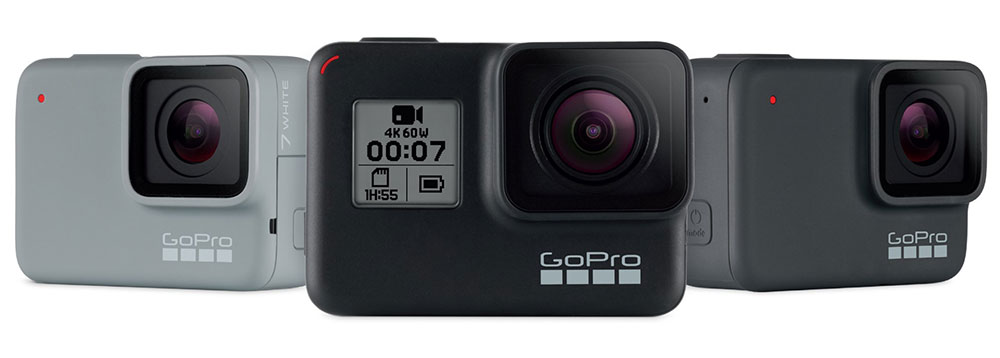
When the new GoPro Hero 7 models were announced I decided it was time to upgrade my old GoPro Hero 3 model to a new version so I can use it on my bike rides for making videos for our Virtual Swanage website and the cycling route sections.
I decided to order the top-of-range Black model as I wanted to be able to record using 4K and the new ‘Hypersmooth’ electronic image stabilisation to make the resulting video much smoother to watch.
I pre-ordered the GoPro 7 Black model with a “Chesty” mount direct from GoPro so I could have the camera attached to me rather than on the handlebars as I had always done in the past. I hoped with the body mount the video would be smoother than the handlebar mount. The camera and accessories were due to arrive on the 2nd of October as the GoPro website showed that as the expected delivery date.
On the 26th of September, I received an email from GoPro to say the camera had shipped and it arrived the next day.
The battery was completely discharged when it arrived so I charged it for several hours on my fast charger and then tried to link the camera with my Samsung Galaxy S6 using the official GoPro app.
After multiple reboots of the camera and phone, I was able to get the app to link to the camera but when it tried to update the firmware on the camera it repeatedly failed and I had to install the GoPro Quik Desktop software to install the latest firmware via the desktop software and the USB-C connection.
For the first trial video, I set the GoPro 7 to use 2K7 video resolution at 50 frames per second with ‘Hypersmooth’ electronic image stabilisation enabled and I had all the other settings set as default. The bitrate for this was 60000kbps.
The video below shows the resulting video footage which has not been edited and was uploaded to YouTube direct from the SD card.
I found when processing the video that the blues on the sky and sea seemed to be very over saturated but when I posted about this on the official GoPro forums many people told me that is the “GoPro look and style”. The battery when recording on this setting only recorded approx. 75 minutes of video before shutting down.
For a second try on the bike today I tried the full 4K 50 frames per second video mode with the following settings configured:
- Video Mode: 4K 50fps
- Bitrate: 78000 kbps
- Hypersmooth enabled
- Shutter: Auto
- EV Comp: -1
- White Balance: 6500K
- ISO Min: 100
- ISO Max: 1600
- Sharpness: High
- Color: Gopro
- FOV: Wide
- Lot Light: Auto
- Video Format: HEVC
The video below is a short clip of the ride from near the Studland gold course to Franks Tank in Studland Heath. I decided to try it on this route as it has sections which are both facing the sun and side to the sun in the afternoon so it would be a good test for the exposure and it is a bumpy track so it would test the electronic image stabilisation.
The high pitch-ticking sound was my cycling jacket zip hitting the case on the camera!
I think the colours with these settings are much better and more natural than the fully automatic profile.
For the return back to Swanage we decided to ride the lower track on the side of the Purbeck Hills so we would have the sun from our right and behind us and there are a lot of darker sections where the trees overhang the track which would test the low light performance and the transition between bright sunlight and shaded areas.
I changed the GoPro to use 1080p 50fps for this section, so I could see how the video quality was at the lower resolution. The bitrate at 1080p 50 was 36000 kbps.
When I tried to edit the video file using the HEVC (H.265) format I found that neither Adobe Premier CS6 or the free version of Davinci Resolve would allow me to import the file. After reading on the Blackmagic forums I found that the full version of Davinci Resolve has support for reading HEVC (H.265) files and so I have now ordered the full version which should arrive sometime next week.
In order to be able to edit using the current software I downloaded the Handbrake video converter and converted one of the HEVC (H.265) files to uncompressed video to import into Davinci Resolve and I was able to edit the footage.
I decided against using this conversion system for future videos due to the time it took to convert a single 3.4Gb HEVC (H.265) file was over 30 minutes on my AMD Ryzen 7 2700X system which has eight cores at 3.7 GHz and 64 Gb ram. The video files were on a Samsung 970 PRO 1TB NVME M.2 SSD and so the drive's speed was not a bottleneck in the conversion format.
The resulting uncompressed file was over 40Gb in size and so with a project with several hours of video footage would result in a huge file size and time to convert.
I have found that the video re-encoding that YouTube applies to uploaded videos seems to cause some blurring and pixelation on fast-moving sections which are not on the original video files.
Comments